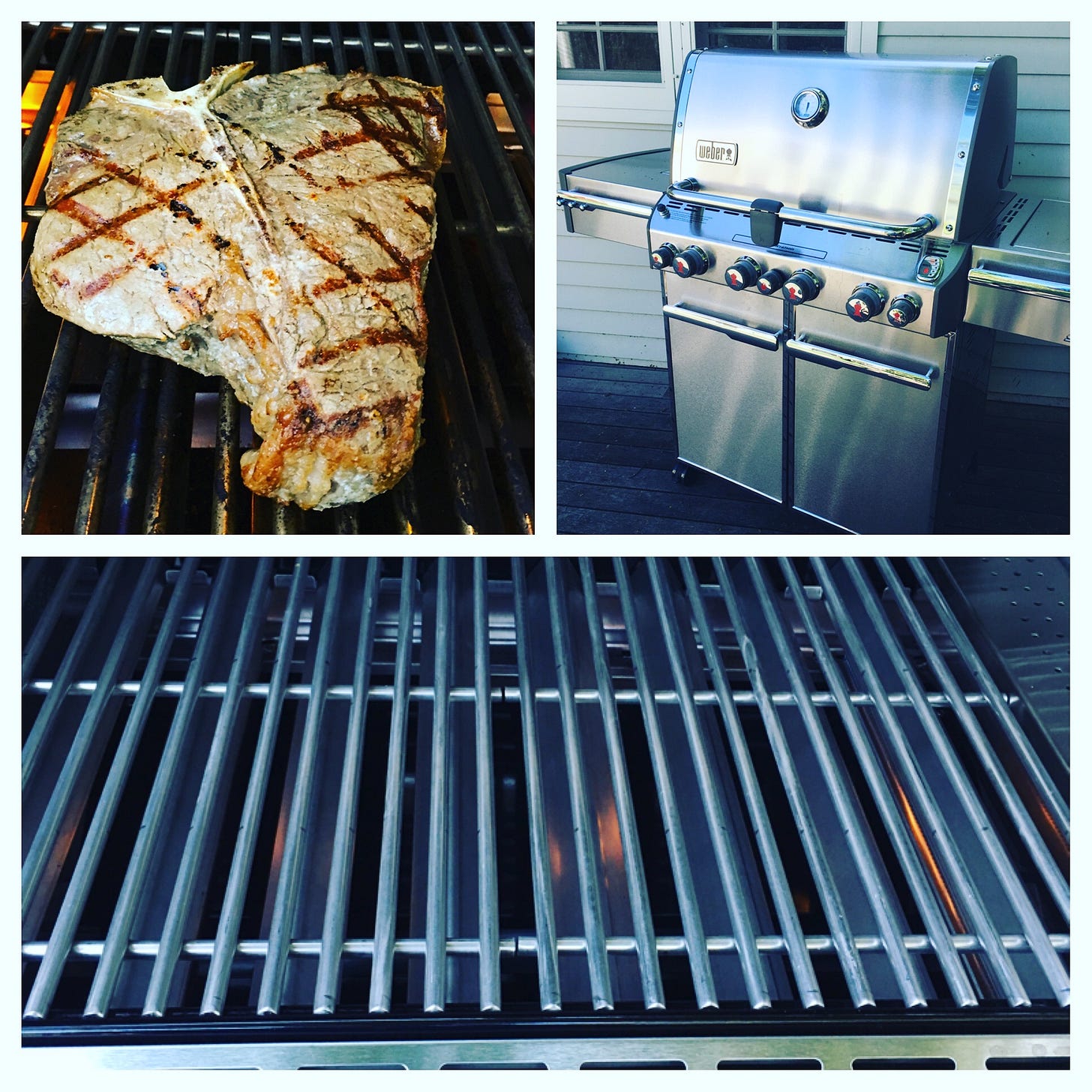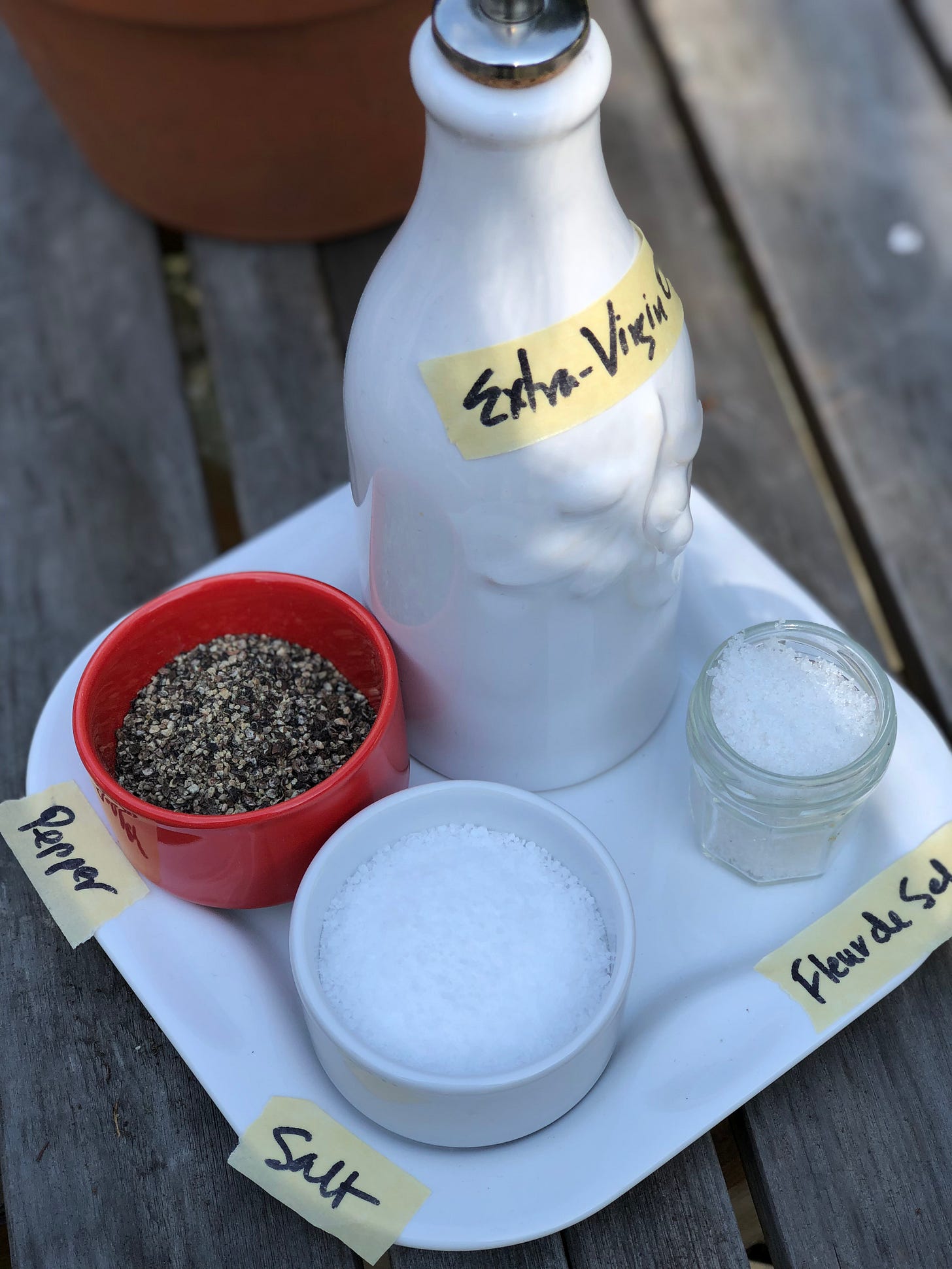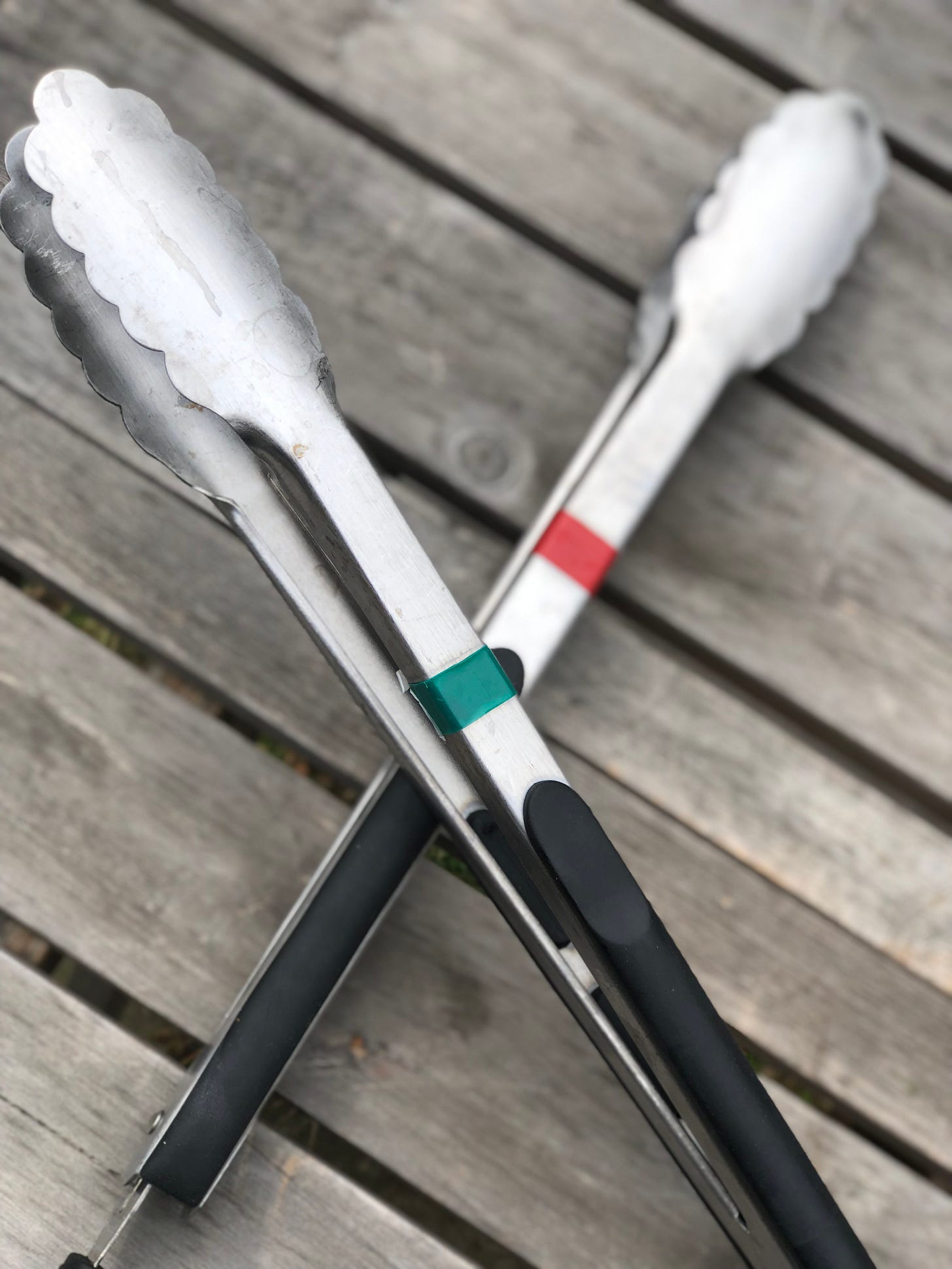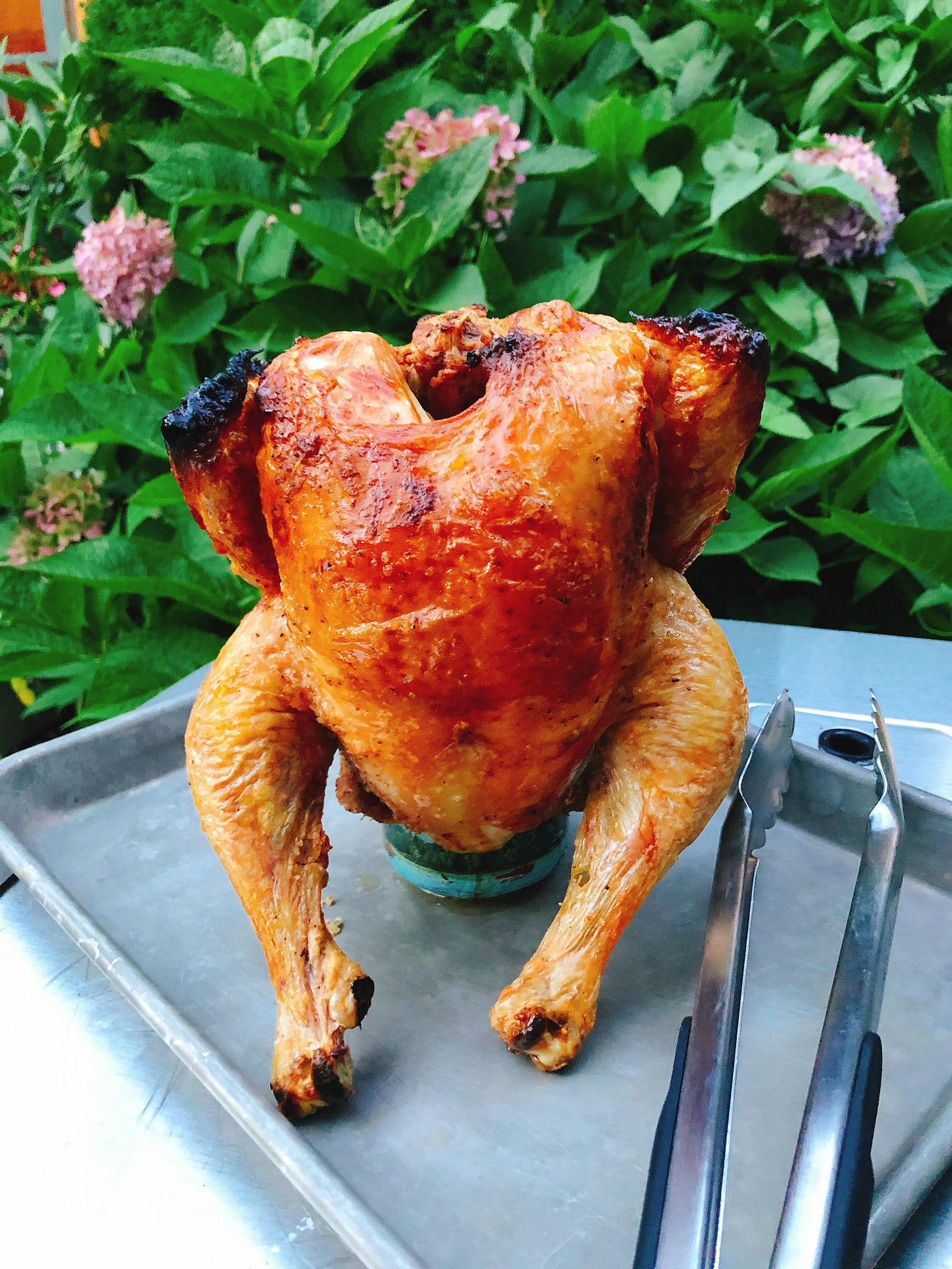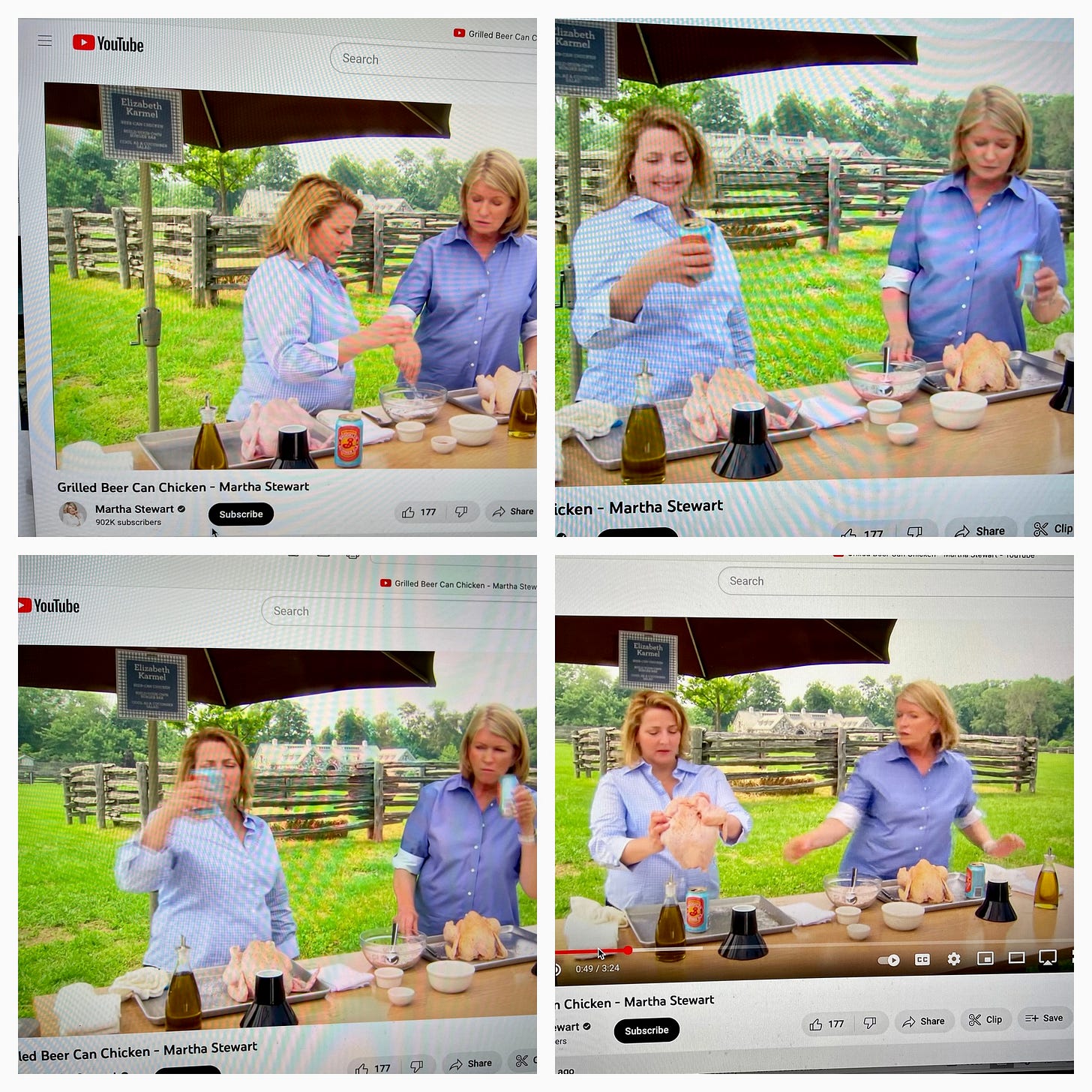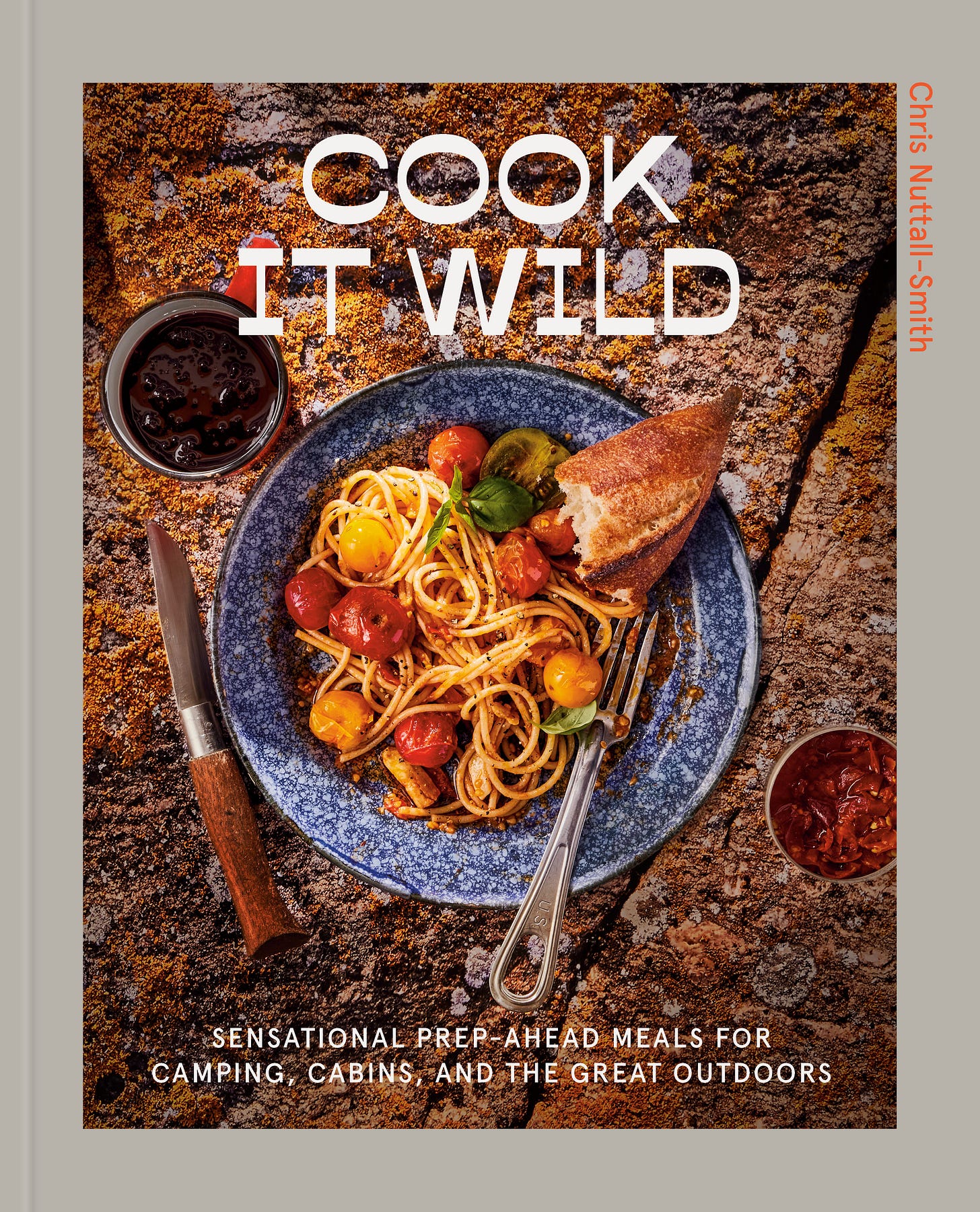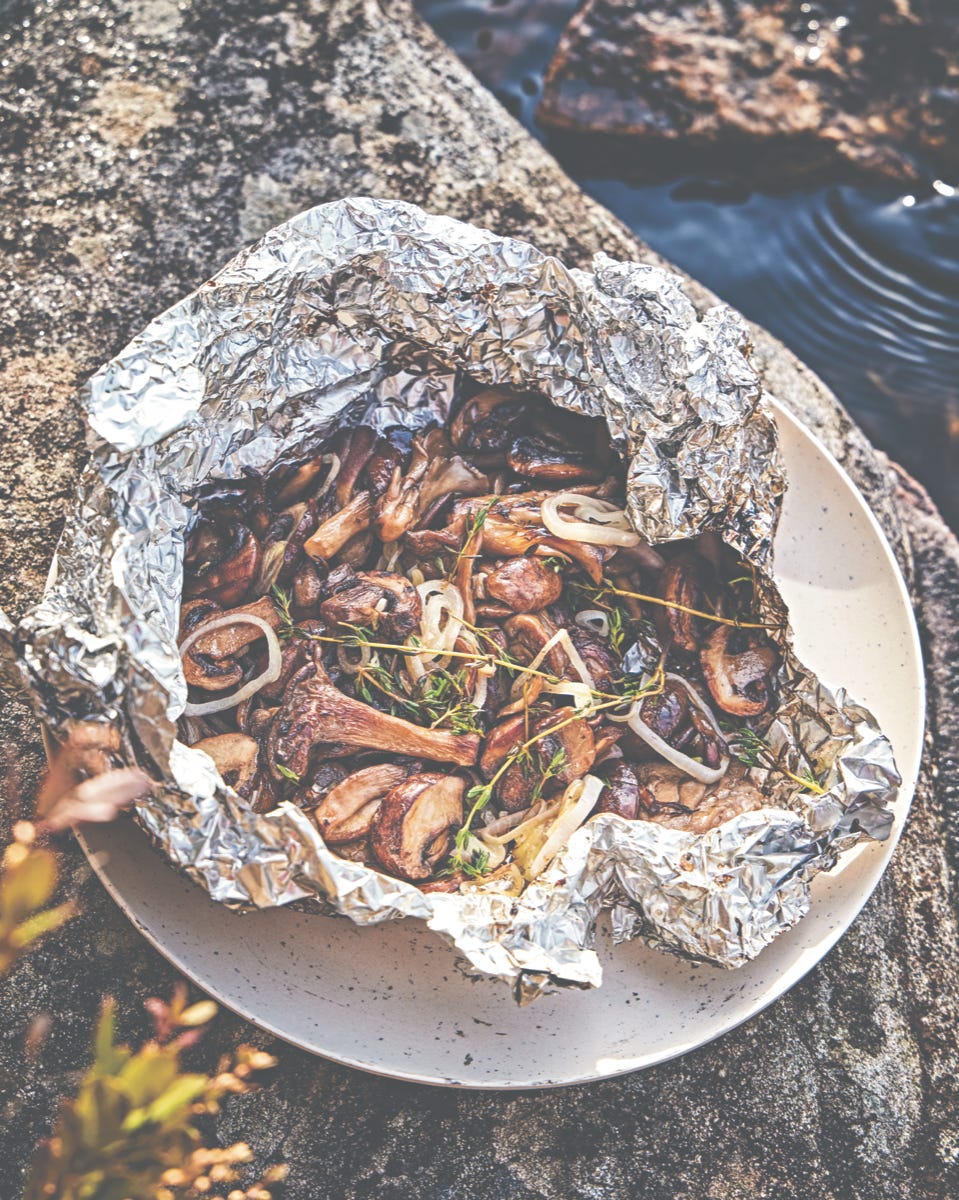AU: So the first “grilling holiday” of the season is behind you. How’d you do? Need any tips? Tricks? Hacks? ANSWERS???!!! Stick around because I’m going to ask Elizabeth all the burning outdoor cooking questions that I have, and answer the questions we get most often!
~ ABOUT US ~
Anthony is an Emmy-Award-winning TV Producer who produced everything from breaking news to lifestyle content at Good Morning America for 10 years and was part of the original team that created The Chew, an award winning cooking and talk show on ABC.
Elizabeth is a PR maven, chef, food writer, and food and beverage consultant who has worked as a spokesperson and logged many hours on TV. She is also the original “Grill Girl” and the author of 4 grilling cookbooks.
Together, they are the creative team that produce the What’s 4 Dinner? newsletter, culinary productions, partnerships, infomercials, and creative content.
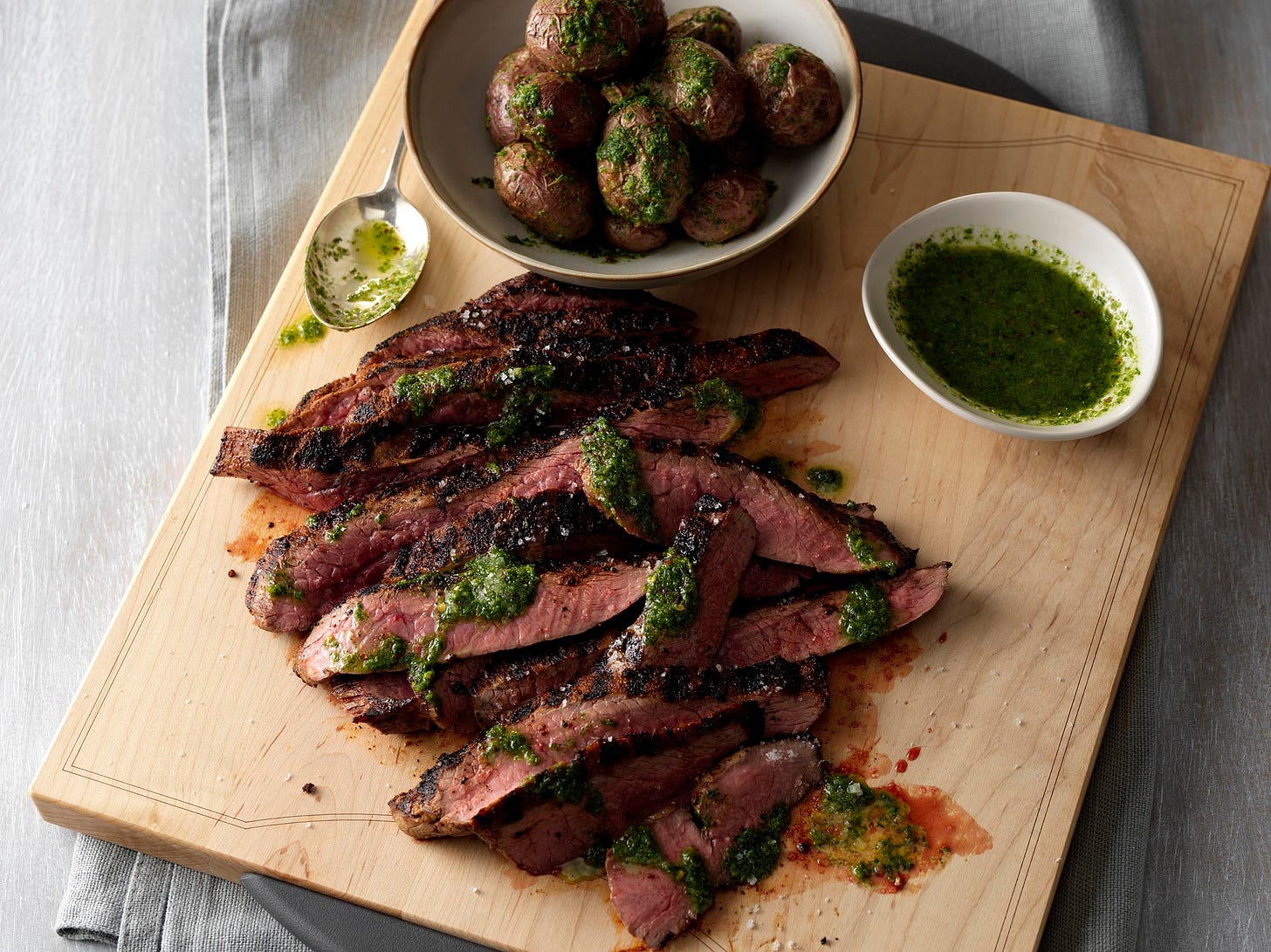
GRILLING SEASON IS OFFICIALLY OPEN!!
EK: Before we get into the questions, I am giving you a couple of links to my website, Girls at the Grill as a refresher.
People ask me all the time, “What kind of grill should I buy?” and I say, buy the biggest and best grill that you can afford, because the better grill you have, the more you will use it (and the better griller you will become).
I can’t tell you how many people have thanked me for that advice because the grills look so big when they are empty, but you can’t believe how fast they fill up when you are cooking on them—and remember, when you cook with Indirect heat, you will lose about 50% of the cooking space.
An electric pellet smoker only cooks using Indirect heat so you won’t lose any cooking space, but it is really only good for low heat and long cooks—it doesn’t do a very good job on steaks, for example.
If you are in the market for a new grill, check out this article on buying a grill.
AU: So let’s start at the beginning… How do I light the fire?
EK: Here is an easy step-by-step guide for both Gas and Charcoal grills.
There are four basic steps to light a gas grill:
Open the lid. Check that all burner control knobs are turned to off and that your Liquid Propane (LP) tank is not empty.
Turn the LP Gas tank on.
Generally, when lighting a gas grill, only one burner should be turned on for ignition. Once the fire has begun, other burners can be turned on and the already lit burner will light the other burners.
Close the lid and preheat until the thermometer reaches 500°-550°F or higher. This will take 10 to 15 minutes. Before cooking, adjust burner controls as recipe directs.
For charcoal grills, see the questions at the end of this newsletter or follow the link above.
EK: It’s important to keep your grill clean. You should brush the grill grates twice a cookout: once after you preheat the grill with all burners on high to remove anything that was stuck-on from the last cook, and then after you take the food off the grill. One of the reasons that you preheat the grill with all the burners on high is to burn off anything that was left from the previous cook. Here is a complete guide to cleaning your grill and smoker. And, I am partial to this grill brush.
AU: Now let’s Get Cooking! Should the lid be open or closed?
EK: I always grill with the lid down. Think of it this way: you would never bake a cake with the oven door open, so don’t grill with the lid open! Once you place the food on the grill, cover the grill with the lid. This helps keep the heat in, which speeds cooking time and cuts down on flare-ups. It also keeps the heat consistent and shields the food from dust, wind, rain and the elements.
AU: What should I grill first? Are there things that are easier than others?
EK: Think about what your favorite foods to eat are and try them. Most of the time, you can cook on the grill only using olive oil, kosher salt and pepper—I call this my grilling trilogy. If you know the difference between direct and indirect heat and when to use it, all you need is the trilogy and the heat of a good grill to make a great meal!
AU: What is your number one grilling rule?
EK: Oil the food, not the grates! This helps to prevent the food from sticking which is a huge issue. Many grillers think if they oil the cooking grates, the food won’t stick. But the reverse is true. Often, the “stickage” is worse because the oil starts to burn and becomes tacky—almost like glue—before they get the food on the grill. When you put un-oiled food on top of sticky, tacky burned oil, it’s like gluing the food to the cooking grates. Your food won’t stick if it is brushed with a thin coat of olive oil and placed on clean cooking grates. Plus the oil promotes caramelization which is the key to those great looking, great tasting grill marks!
The other most important tip is don’t try to turn the food too early. Most food—especially protein—initially sticks to the grill. Once it is cooked on one side, it will naturally release and you’ll be able to flip with ease using only tongs. If it sticks, it’s probably not ready to flip.
AU: What’s the most common grilling mistake you see?
EK: The most frequent mistake I see is people choosing the wrong cooking/grilling method. There are three types of grilling: direct, indirect, or a combo.
DIRECT = Food that takes less than 20 minutes
INDIRECT = Food that takes more than 20 minutes
COMBO = Sear over DIRECT heat for 1-2 minutes a side, and move to INDIRECT heat to finish cooking
EK: My rule of thumb is anything that takes 20 minutes or less to cook uses the direct method, and if the food takes more than 20 minutes to cook, I use the indirect cooking method. Here is more information on the cooking/grilling methods.
Once you’ve mastered the direct and indirect cooking methods, you can use the combo method: sear over direct heat and finish cooking over indirect. This is the method that I use the most. Searing everything from thick steaks to roasts over direct heat and finishing the cooking over a gentle indirect heat.
If you don’t know how long your food will take to cook, think about it this way: The heavier and denser the food, the longer it will take to cook. If a potato and a large shrimp are about the same diameter, how do you cook them? The heavier and denser potato needs indirect heat to cook through, and the quick-cooking shrimp needs direct heat.
AU: I know a lot of people think that grilling over the highest heat possible is how to get that “good char.” Is that true?
EK: More than likely, you will be burning the exterior of your food and the interior will be raw. Many people think that grilling meat for a short time at high temperatures seals in juices. Actually, all this does is to burn the meat on the surface and while leaving it raw on the inside.
You will get great grill marks, a.k.a. “good char” if you use the grilling trilogy and brush all your food with EVOO before seasoning it. The oil promotes caramelization (good char) and keeps the food juicy. I get my best grill marks by searing over a higher direct heat and moving to indirect heat, a.k.a. the Combo method. You don’t want to actually “char” your food which literally means to burn or reduce to charcoal.
AU: People think grilling is more hands-on than it really is, what are they doing wrong?
EK: I think we see “grilling” on tv and think it’s supposed to be high-stakes action, but it’s actually a very hands-off technique! Remember, it’s a heat source just like your stove or oven—only outdoors.
Too-frequent “peeking” Repeatedly lifting the lid to check the food while it’s cooking lengthens cooking time.
Too-frequent flipping The rule of thumb is to only turn food once, halfway through grilling time—this will help seal in juices and keep all foods from burgers to fish from sticking and breaking apart.
AU: Speaking of raw and cooked food, what should we do about food safety?
EK: Follow my Tong Tip!!! I have been color-coding my tongs with red and green duct tape since I started grilling. The color-coding helps prevent cross-contamination of raw and cooked foods. The different colors help me to remember which pair of tongs I used for raw food, like chicken, and which are safe to use for the cooked food. I use the international colors of RED (STOP) and GREEN (GO) to make it easy to remember which tongs to use while cooking and which tongs to use once the food is done. Red means STOP, Raw food touched these and Green means GO, cooked food—or foods that don’t carry any bacteria like vegetables—touched these.
AU: What happens if I set the grill on fire? Asking for a friend.
EK: This can be a big flare-up or a full-blown fire—I’ve experienced both! The first step is to remove the food and cover the Grill. If it is a gas grill, turn the burners off and turn the gas off (tank or natural gas) immediately. If it is an electric pellet smoker, unplug it immediately.
The quickest way to extinguish flare-ups is to put the lid on the grill. The lid will reduce the amount of oxygen that feeds the fire—thus limiting or snuffing-out the flare-ups. If it’s a charcoal grill, close the lid, and close the vents on the top and bottom to cut off oxygen to the fire.
FIRE HACK: If the fire is full-blown, it almost always means that it is a grease fire. This can happen even when the grill is clean, but it happens less if you have a clean grill and ensure the grease pans are empty. Turn the burners off if it is a gas or electric grill and pour a box of kosher salt over the burners and the flames to snuff them out. I keep a box of kosher salt near the grill in case I need it.
AU: Can I use a water bottle to spray flare-ups while I am grilling?
EK: No. Spraying water on a hot fire can produce steam vapors which may cause severe burns. The water can also crack the porcelain-enamel finish on the inside of your grill, resulting in damage to the finish of the grill.
AU: They sell so many grilling tools. What accessories do I really need?
EK: There are some need-to-have and some nice-to-have accessories, but beware that many of the tools sold for grilling don’t really work well.
I especially dislike the awkward, long, bulky, heavy tongs and the barbecue fork. You have no control with those tongs that never line-up accurately. You should use 12-inch locking chef tongs instead. I recommend two pairs so you can make a pair of Stop and Go Tongs (see Tong Tip above) to help prevent cross contamination. They are great for all indoor and outdoor tasks!
And, never pierce food with a fork, it will cause food to release juices. Always use 12-inch chef tongs or a spatula to turn food over or remove it from the grill.
To tell if the food is done, use an instant-read meat thermometer. My favorite is the Thermapen and it happens to be on sale right now.
AU: I want to know what is YOUR favorite thing to grill and should I be making it, too?
EK: When people ask me this question, I always say that my favorite thing to grill is whatever I am cooking. I am not being cheeky, it’s the truth. I truly believe grilling and barbecuing on an outdoor grill is the best way to prepare food, bar none. Open fire promotes caramelization, so you don’t need much extra fat or sauces to flavor the food. It’s a perfect way to bring out the inherent goodness of high-quality ingredients.
EK: That said, my back-pocket dinner is Beer-Can Chicken. I buy the best chicken that I can find, rub the entire thing with EVOO, season it liberally with a seasoned coarse salt mixture—but even plain salt and pepper is great—place the whole chicken on a beer can, and make sure that the legs are positioned in front of the chicken like a tripod. Grill over indirect medium-high heat for 45-60 minutes.
EK: IMO, it’s as close to a French rotisserie chicken that I have ever had in the USA! Here’s a screen grab of me showing Martha Stewart how to make Beer-Can Chicken a few years ago...
AU: What is an unexpected item that is delicious when grilled – something that people would not think of?
EK: Bananas! I am bananas for grilled bananas! Leave the banana in the peel, slice the banana lengthwise and sprinkle with a little dessert rub (cinnamon, granulated sugar and a pinch of salt) on the cut side of the banana. Grill the banana over medium-low direct heat, skin-side down until the skin peels away from the flesh. That’s when you know that it is done. You can also turn the bananas once for a minute or so to get grill marks on the cut side. Serve with ice cream and bourbon for a bananas foster-like treat or home-made chocolate sauce for a grilled banana split sundae.
AU: I know that we have some diehard charcoal grillers and these are the top three charcoal grilling questions:
AU: How do I light the Fire if I am using Charcoal?
EK: Use a chimney starter and either a tasteless, odorless and non-toxic paraffin firestarter or a crumpled sheet of newspaper. Never use gasoline and other highly volatile fluid to ignite charcoal. If you use lighter fluid, never add it to hot or even slightly warm coals and beware that the lighter fluid will flavor your food if you don’t burn it off entirely—I am not a fan of lighter fluid!
AU: Can I start grilling as soon as I see flames?
EK: Do not cook on the charcoal when you can still see flames. Charcoal briquets take 25-30 minutes to reach their desired temperature. You know that the charcoal is ready to cook on when it is covered with a white-gray ash and glowing red under the ash. And that “hand over the charcoal thing while saying Mississippi” doesn’t work to gauge the heat of the fire. Everyone has a different heat tolerance and it’s not a good indicator of heat.
AU: My charcoal was fired up and when I put the lid on the grill, the fire went out. What did I do wrong?
EK: This is one of the biggest mistakes. You most likely choked the fire or cut off the air supply. Air vents should be opened before lighting briquets and left open while grilling. This is actually how you regulate the heat on a charcoal grill. The more open the vents, the more the oxygen, and the fire feeds off oxygen. For the hottest fire, open the top and bottom vents all the way. For a cooler fire, open them halfway and to extinguish the fire, close the vents. No oxygen = no fire!
WIN A COPY OF “COOK IT WILD” !!
EK: One of the most original outdoor cooking books that we’ve seen in a long time is the new Cook It Wild: Sensational Prep-Ahead Meals for Camping, Cabins, and the Great Outdoors. Written by Top Chef Canada resident judge and celebrated food writer Chris Nuttall-Smith and published by Clarkson Potter, this is a serious cookbook with the goal of a delicious but easy meal in the great outdoors. It was written as a camping cookbook. But we say, that camp can be your own backyard!
Basically, it’s all about the pre-prep, and who doesn’t want everything to be prepped before they host a cookout?
Flavor-packed dishes for the great outdoors include recipes that you don’t ordinarily think of like Vegan Dan Dan Noodles, and Fire-Baked Pecan Sticky Buns. Each recipe is divided into “at home” and “at camp” sections, so most of the cooking is done before your meal.
Elizabeth immediately wanted to make the Beautifully Basic Mushroom Roast—a modern day “boy-scout foil pack” to go along with Beer-can chicken and Anthony is obsessed with the Golden-Crisp Fish in Lemon & Caper Butter and the Campfire Paella.
*Paid subscribers will automatically be entered into the Book Giveaway. If you’re not a paid subscriber, hit the button below by Monday June 5, 2023 at 11:59pm PT.





